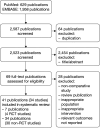Survival Benefit of Myeloablative Therapy with Autologous Stem Cell Transplantation in High-Risk Neuroblastoma: A Systematic Literature Review
- PMID: 38401028
- PMCID: PMC10963547
- DOI: 10.1007/s11523-024-01033-4
Survival Benefit of Myeloablative Therapy with Autologous Stem Cell Transplantation in High-Risk Neuroblastoma: A Systematic Literature Review
Abstract
Background: Multimodal treatment of newly diagnosed high-risk neuroblastoma (HRNB) includes induction chemotherapy, consolidation with myeloablative therapy (MAT) and autologous stem cell transplantation (ASCT), followed by anti-disialoganglioside 2 (GD2) immunotherapy, as recommended by the Children's Oncology Group (COG) and the Society of Paediatric Oncology European Neuroblastoma (SIOPEN). Some centres proposed an alternative approach with induction chemotherapy followed by anti-GD2 immunotherapy, without MAT+ASCT.
Objective: The aim of this systematic literature review was to compare survival outcomes in patients with HRNB treated with or without MAT+ASCT and with or without subsequent anti-GD2 immunotherapy.
Patients and methods: The review followed the Preferred Reporting Items for Systematic Reviews and Meta-Analyses (PRISMA) guidelines. MEDLINE via PubMed and EMBASE databases were systematically searched for randomised controlled trials (RCT) and observational comparative studies in patients with HRNB using search terms for 'neuroblastoma' and ('myeloablative therapy' OR 'stem cell transplantation'). Reporting of at least one survival outcome [event-free survival (EFS), progression-free survival, relapse-free survival and/or overall survival (OS)] was required for inclusion. Outcomes from RCTs were synthesized in meta-analysis, while meta-analysis of non-RCTs was not planned owing to expected heterogeneity.
Results: Literature searches produced 2587 results with 41 publications reporting 34 comparative studies included in the review. Of these, 7 publications reported 4 RCTs, and 34 publications reported 30 non-RCT studies. Studies differed with respect to included populations, induction regimen, response to induction, additional treatments and transplantation procedures. Subsequent treatments of relapse were rarely reported and could not be compared. In the meta-analysis, EFS was in favour of MAT+ASCT over conventional chemotherapy or no further treatment [hazard ratio (HR) = 0.78, 95% confidence interval (CI) 0.67-0.91, p = 0.001] with a trend favouring MAT+ASCT for OS (HR = 0.86, 95% CI 0.73-1.00, p = 0.05). Tandem MAT+ASCT was found to improve EFS compared with the single procedure, with improvement in both EFS and OS in patients treated with anti-GD2 therapy. Non-RCT comparative studies were broadly consistent with evidence from the RCTs; however, not all reported survival benefits of MAT+ASCT (single or tandem). Limited comparative evidence on treatment without MAT+ASCT in patients treated with anti-GD2 immunotherapy suggests an increased risk of relapse. In relapsed patients, MAT+ASCT appears to improve OS, but evidence remains scarce.
Conclusions: Survival benefits in patients treated with MAT+ASCT confirm that the procedure should remain an integral part of multimodal therapy. In patients treated with anti-GD2 immunotherapy, limited evidence suggests that omitting MAT+ASCT is associated with an increased risk of relapse, and therefore, a change in clinical practice can currently not be recommended. Evidence suggests the use of tandem MAT+ASCT compared with the single procedure, with greater benefits observed in patients treated with anti-GD2 immunotherapy. Limited evidence also suggests improved survival following MAT+ASCT in relapsed patients, which needs to be viewed in light of emerging chemoimmunotherapy in this setting.
© 2024. The Author(s).
Conflict of interest statement
UZ and WB received travel grants from EUSA Pharma; AW provided expert opinion to EUSA Pharma. JW is an employee of EUSA Pharma.
Figures



Similar articles
-
Lack of survival advantage with autologous stem-cell transplantation in high-risk neuroblastoma consolidated by anti-GD2 immunotherapy and isotretinoin.Oncotarget. 2016 Jan 26;7(4):4155-66. doi: 10.18632/oncotarget.6393. Oncotarget. 2016. PMID: 26623730 Free PMC article.
-
Anti-GD2 antibody-containing immunotherapy postconsolidation therapy for people with high-risk neuroblastoma treated with autologous haematopoietic stem cell transplantation.Cochrane Database Syst Rev. 2019 Apr 24;4(4):CD012442. doi: 10.1002/14651858.CD012442.pub2. Cochrane Database Syst Rev. 2019. PMID: 31016728 Free PMC article.
-
The Role of Autologous Stem-Cell Transplantation in High-Risk Neuroblastoma Consolidated by anti-GD2 Immunotherapy. Results of Two Consecutive Studies.Front Pharmacol. 2020 Oct 30;11:575009. doi: 10.3389/fphar.2020.575009. eCollection 2020. Front Pharmacol. 2020. PMID: 33324208 Free PMC article.
-
Autologous Transplantation for Newly Diagnosed Multiple Myeloma in the Era of Novel Agent Induction: A Systematic Review and Meta-analysis.JAMA Oncol. 2018 Mar 1;4(3):343-350. doi: 10.1001/jamaoncol.2017.4600. JAMA Oncol. 2018. PMID: 29302684 Free PMC article.
-
Targeted immunotherapy for high-risk neuroblastoma--the role of monoclonal antibodies.Ann Pharmacother. 2013 Feb;47(2):210-8. doi: 10.1345/aph.1R353. Epub 2013 Feb 5. Ann Pharmacother. 2013. PMID: 23386066 Review.
Cited by
-
From Local to International Approach: Prognostic Factors and Treatment Outcomes in Neuroblastoma-A 30-Year Single-Center Retrospective Analysis.Children (Basel). 2025 Apr 19;12(4):525. doi: 10.3390/children12040525. Children (Basel). 2025. PMID: 40310212 Free PMC article.
-
Efficacy and Safety of Anti-GD2 Immunotherapy with Dinutuximab Beta in the Treatment of Relapsed/Refractory High-Risk Neuroblastoma.Target Oncol. 2025 Jul;20(4):551-568. doi: 10.1007/s11523-025-01155-3. Epub 2025 Jun 3. Target Oncol. 2025. PMID: 40459700 Free PMC article.
References
Publication types
MeSH terms
LinkOut - more resources
Full Text Sources
Medical

